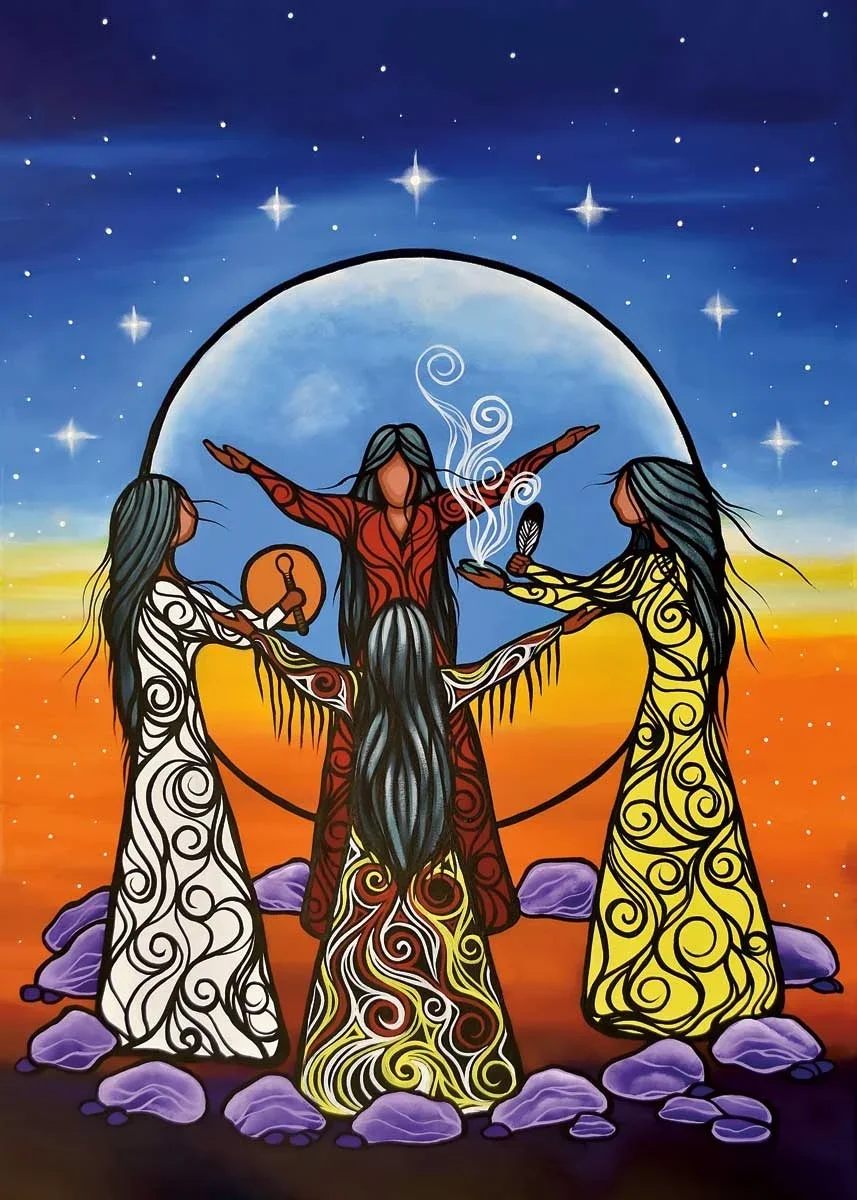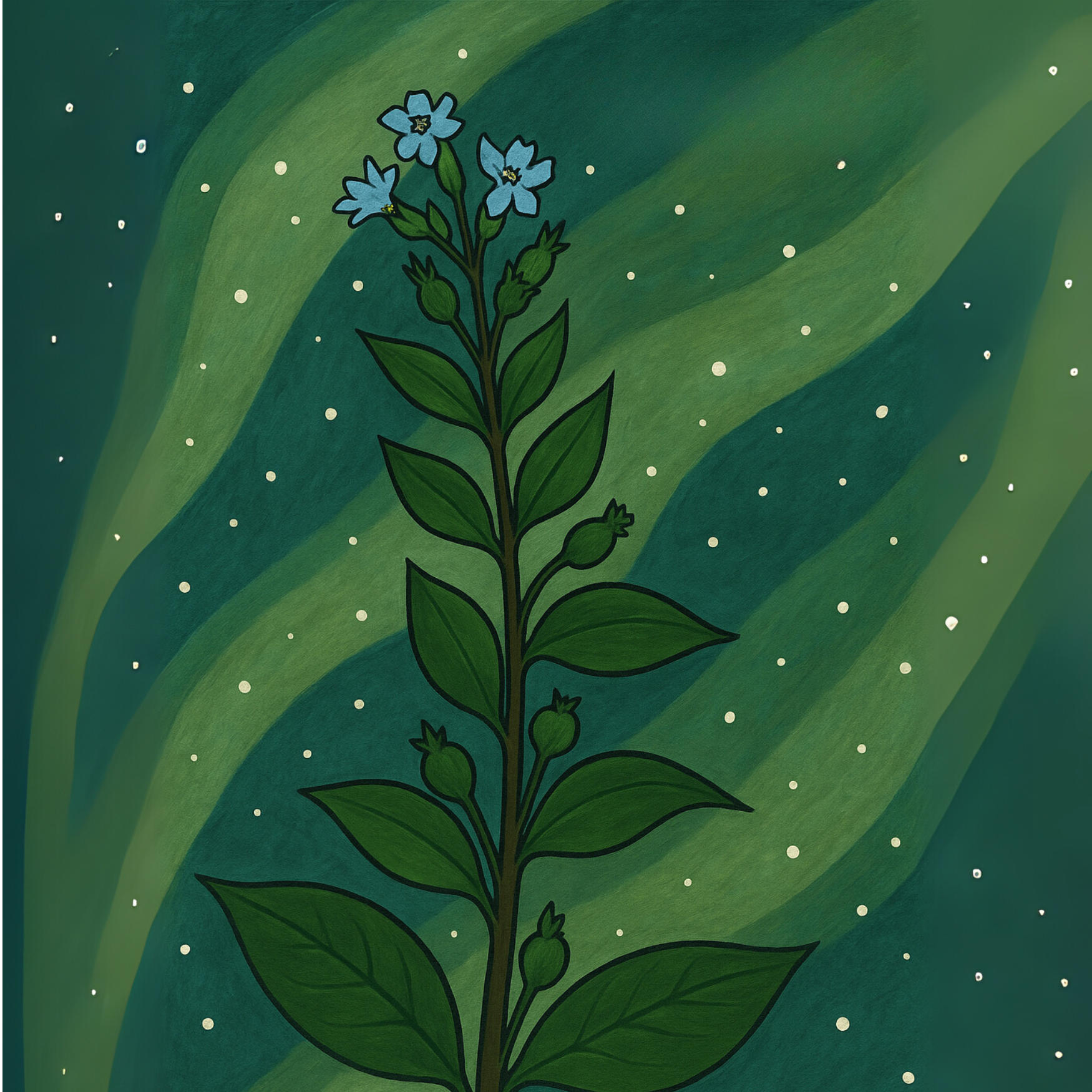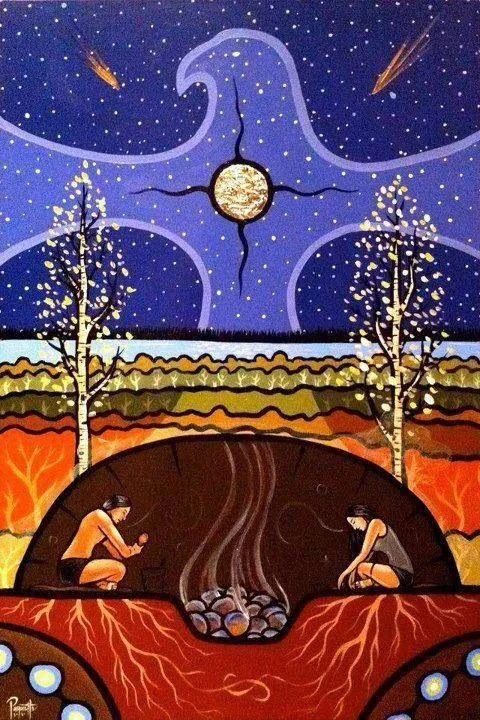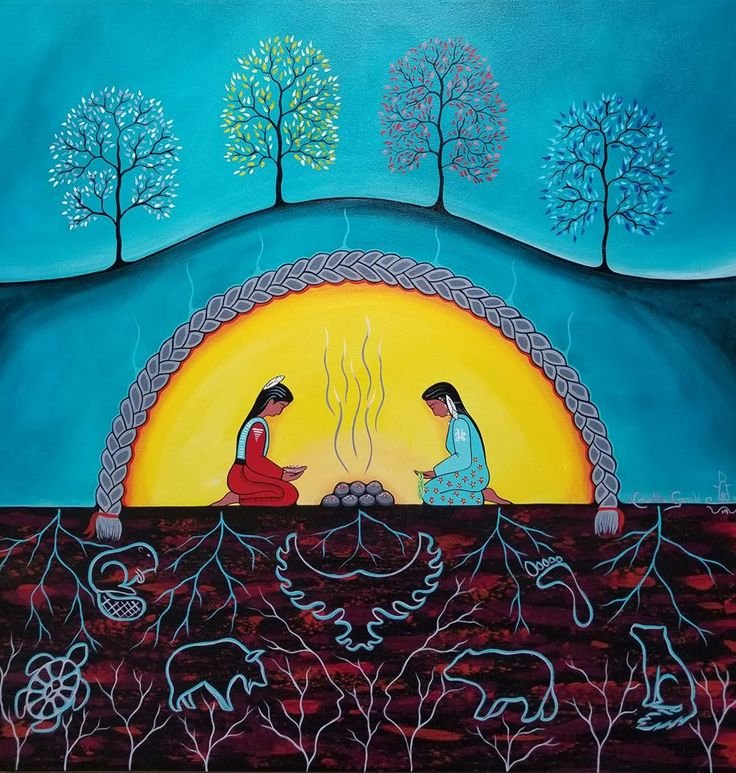
Ceremony & Spiritual Healing
The Role of Ceremony in Healing
Ceremony is a central part of many Indigenous cultures, restoring balance, identity, and connection to community. It supports emotional, physical, mental, and spiritual well-being. For many, participating in ceremony is a way to process trauma, release pain, and strengthen resilience.
Traditional Healing Practices:
Traditional Indigenous healing practices focus on purification, renewal, and transformation. These practices promote physical, emotional, and spiritual healing while nurturing resilience.
Healing-informed care is rooted in a strengths-based approach unique to each culture, but grounded in shared Indigenous worldviews, ways of knowing, and cultural traditions. When rooted in a cultural framework, healing practices remain true to the concepts of vision, circles of relationship, and hope.
Art by: Jackie Traverse
Smudging
Smudging is the act of wafting sacred smoke over oneself or others for purification. It is a deeply personal practice, with each person developing their own way of smudging. Some people draw the smoke toward their head, throat, arms, trunk, and legs, while others have an Elder fan the smoke over them using a feather.
Smudging is used for medicinal, practical, and spiritual purposes. The traditional practice involves prayer and the burning of the Four Sacred Medicines: cedar, sage, sweetgrass, and tobacco.
Tobacco
Used as an offering in every ceremony and for every request to the spirits.
Acts as a means of communicating thoughts and feelings in prayer.
It is customary to offer tobacco to Elders, Medicine People, or healers when seeking guidance (often in a tobacco tie).
Traditional tobacco is sacred and honored, used to show respect for all living things and to give thanks to Creation.
Sage
Used to prepare people for ceremonies and teachings.
Helps release troubling thoughts and remove negative energy.
Cleanses homes, sacred items, and people before important events.
Cedar
Purifies spaces and protects during ceremonies.
When burned with tobacco, cedar crackles—signaling the spirits to take notice of the offering.
Commonly used in fasting and sweat lodge ceremonies, with cedar branches covering the lodge floor or encircling the lodge for protection.
Sweetgrass
Known as the “sacred hair” of Mother Earth. Its sweet scent represents her gentleness, love, and kindness.
Used for smudging, purification, and in healing circles to create a calming effect.
For the Mi’kmaq and many other Indigenous peoples, sweetgrass has been used for centuries in peace and healing rituals.
Traditionally dried and braided. The smoke from a smoldering braid purifies participants, protects from negative energies, and carries prayers to the Creator and messages to ancestors.
Sweetgrass Teaching
A braid of sweetgrass contains 21 strands, each with symbolic meaning:
First 7 strands – Represent the seven generations before us—our parents, grandparents, and ancestors. They shaped the paths we walk today.
Second 7 strands – Represent the Seven Sacred Teachings: love, respect, honesty, courage, wisdom, truth, and humility.
Love is powerful when we live it, not just speak it.
Humility teaches that no one is greater than another—we are all human beings.
Self-love and self-respect are essential before we can love or respect others.
Final 7 strands – Represent yesterday, today, and tomorrow; mind, body, and spirit; man, woman, and child; man, woman, and Creator.
(Teaching shared by Anishinabe Elder Wally Chartrand)
Purpose of Smudging
The smoke from the sacred medicines carries the prayers of the people to the Creator. Smudging improves spiritual health, purifies the body and soul, clears the mind, and helps individuals become mindful, grounded, and present. It can also cleanse spaces and disperse negative energy.
We Smudge To:
Clear the air around us
Clear our minds so we hold good thoughts of others
Clear our eyes so we see the good in others
Clear our ears so we hear only positive words about others
Clear our mouths so we speak well of others
Clear our whole being so we act with kindness and respect
Drumming
Drumming is a sacred and traditional part of Indigenous culture. The drum represents the heartbeat of Mother Earth—the heartbeat of life and of our people. We spend the first nine months of our lives in our mother’s womb, listening to her heartbeat. That rhythm sets the pattern of our existence.
In ceremonies, the drum is played to invite the spirit of the Creator. It is a tool that builds lifelong connections and relationships with all living things. The voice of the drum expresses our connection to all of creation, and when we drum together, we strengthen our connection to each other.
We are connected to our own spirits through drumming. The drumstick, used to bring the drum to life, is sometimes referred to as the arm of the Creator, breathing life into the ceremonies. As the central element of many ceremonies, the drum holds a place of great honour. Its beats call to the spirits and ancestors, inviting them to join and guide the gathering.
Art by: Betty Albert
Sweat Lodge
The sweat lodge is a sacred place of spiritual communication and cleansing. It is traditionally constructed from young willow saplings arranged in a specific pattern, with the doorway always facing east.
Inside, participants sit in a circle around preheated rocks, which are used to create heat and steam for the ceremony. The sweat lodge is a time for reflection, prayer, and spiritual renewal. It teaches respect, patience, endurance, and the freedom to speak from the heart.
During a sweat lodge ceremony, purification takes place on both a physical and spiritual level. As your body sweats, impurities are released through the pores, and this physical cleansing is offered back to the Creator. This act symbolizes spiritual purification, as the release of sweat represents letting go of what no longer serves you.
Fire plays a central role in the ceremony, used to burn sacred offerings and heat the rocks. Water is then poured onto the heated rocks, creating steam that fills the lodge and raises the temperature, enhancing the cleansing process. The combination of fire, water, earth, and air during the sweat lodge connects participants to the elements, the Creator, and the community, fostering healing and balance.
Art by: Loretta Gould
Ceremony
Reintroducing ceremony is vital to the health and well-being of Indigenous communities. Healing Indigenous people requires opportunities to reconnect with cultural traditions, and in doing so, rediscover a sense of belonging and personal identity.
Strengthening community bonds through ceremony significantly reduces the likelihood of violence. When life is spent celebrating others and fostering deep connections within the community, acts of violence become far less likely.
Ceremony acts as a form of justice, promoting harmony within individuals and across the community. It fosters strong connections to the land, a sense of belonging, and a deep understanding of identity and self—powerful foundations for personal growth, particularly for women.
Ceremonies provide a sacred space to honor the roles of women as life-givers, healers, and leaders. They also create opportunities for the presence of respected Elders, whose teachings and wisdom guide the community and ensure cultural knowledge is carried forward.
Plant Medicines
Harvesting, grinding, and preparing traditional plant-based medicines is a meaningful way to connect with nature and care for the body. Many berries, flowers, trees, and other plants offer natural soothing and healing properties. For example, sage is often harvested to help cleanse and heal the mind, emotions, body, and spirit.
Growing Traditional Tobacco
It is important to understand that traditional tobacco and commercial tobacco are very different. Traditional tobacco is a pure, natural plant that is grown and used without the additives or modifications found in commercial products. In its natural form, traditional tobacco is used with the utmost respect in ceremonies, prayers, and offerings, and holds significant spiritual, cultural, and health benefits.
Art by: Carrie Armstrong
How to Grow Traditional Tobacco
Materials Needed:
Tobacco seeds
Transparent, reused plastic container with a lid
Potting soil
Mist/spray bottle for water
Steps:
Timing – Begin in mid-April to give seeds time to sprout and grow before transplanting them outdoors.
Prepare the Soil – Place a few inches of potting soil into the container. Break up large clumps and level the surface.
Plant the Seeds –
Place seeds about 1 inch apart on top of the soil.
Gently press them down with your fingertip, but do not cover them—tobacco seeds need sunlight to germinate.
Because seeds are tiny, use a small spoon to place them carefully.
Watering – Mist lightly with water. Avoid overwatering or drowning the seeds.
Sunlight & Moisture –
Close the lid or cover the container and place it on a sunny windowsill.
Mist whenever the soil begins to dry to keep it evenly moist.
Growing – After 4–6 weeks, plants will be strong and several inches tall. Remove the lid once they outgrow the container.
Transplanting – Move plants to a sunny outdoor garden spot after the last frost. By July, large green leaves should develop.
Harvesting – At summer’s end, harvest the leaves and dry them indoors on a screen or by hanging them upside down.
Saving Seeds – Collect seed pods at the end of the season and store them in a paper bag.
Sharing the Knowledge – Share seeds and the teachings of growing traditional tobacco so others can cultivate their own sacred medicine.
Sharing Circles
Sharing circles are an essential part of the oral traditions of Indigenous communities and have been a cornerstone of culture for centuries. They provide a space for individuals to gather, share experiences, and connect with one another. Knowledge is passed down through Elders, families, friends, and other community members who share their wisdom.
In Indigenous culture, the circle is a powerful and recurring symbol found in nature, representing wholeness, completion, and the cycles of life. A sharing circle is a facilitated gathering where participants sit in a circle and take turns speaking about a specific topic. This creates a safe and supportive environment where individuals can be vulnerable, share their stories, and listen to others without judgment.
The strength of a sharing circle lies in its ability to foster deep connections, mutual understanding, and community support. Participants gain personal insight by reflecting on their experiences, listening to others, and practicing the art of attentive, respectful listening. This process encourages personal growth, healing, and a stronger sense of belonging.
Instructions for Facilitating a Sharing Circle
Opening – Begin with a Smudge and an opening prayer.
Setting the Tone – Clearly state that the sharing circle is a safe space. Emphasize equality, interconnectedness, and the value of coming together in unity.
Using the Talking Piece – Introduce a talking piece, such as a feather or another culturally significant item, which is passed clockwise around the circle.
Sharing and Listening –
While holding the talking piece, a participant may share their thoughts, feelings, or stories, or choose to pass.
Each person shares without interruption.
All other participants listen attentively and respectfully, valuing differences of opinion.
Confidentiality – What is shared in the circle stays within the circle. Participants may not repeat others’ stories outside the gathering.
Connection and Wholeness – Sitting face-to-face in the circle engages mind, body, heart, and spirit, creating a meaningful and authentic exchange. This fosters a strong sense of community and connection “in a good way.”
Art by: Eruoma Awashish
Language Classes
Language classes inform the cultural worldview, ways of knowing, knowledge systems, values and practices. Language classes connect us to each other and our culture.
Stories and Artwork
Writing stories and creating artwork illustrates and clarifies values. It connects us to each other and our culture. It also conveys culturally specific values, including high expectations, caring, support and opportunities for participation.
Visiting
Visiting encourages people to tell their stories and to connect with each other. It can release internalized pain and may help show a connection between thought and feeling. Visiting can also help people get in touch with their purpose.
Debriefing
The purpose of debriefing is to reduce traumatic stress, increase coping skills and facilitate group solidarity among people who have experienced trauma. Debriefing can reduce the possibility of psychological harm by talking about what happened. Facts can be reviewed, misconceptions corrected as well as valid and fair observations taken on board. The information can be used to analyze the critical event and help prevent further incidents. It allows the group or individuals to look at the incident as a whole and can result in suggestions to improve further responses and gives staff time to go over the incident.











